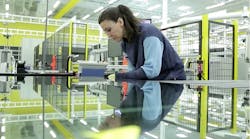We produce dynamic glass at SageGlass, but we know we are truly in the business of people. Our principles are adopted from our parent company, Saint-Gobain, and advise every member of our team as well as influence our company culture and dynamic.
However, this focus on people is not just about our customers. It starts with our team—every individual working at SageGlass—and the tone for how we treat one another starts with me, the CEO. I take leadership and team member engagement seriously. After all, our company culture impacts how we treat our customers, suppliers and partners.
I have a technical background—a PhD in polymer physics—yet during my career I made a conscious shift towards management and rose through the ranks at several organizations before leading SageGlass. I’ve learned a lot about leadership over the years, but there is one truth I can’t deny: CEOs simply don’t matter anymore.
That may seem like a bold statement, but what I mean is that CEOs shouldn’t be calling most of the shots. If we’re leading our teams the way we’re supposed to, they should feel empowered to make the majority of decisions and lean on the CEO for support.
Too often CEOs expect their teams to serve them, but that’s not my philosophy. I firmly believe it’s the primary responsibility of a CEO to be humble and serve the needs of their team in order to empower the individual, and I bring this attitude to work every day. This approach creates an environment where we can all feel comfortable creating something better than what we have. However, this type of environment does not happen overnight.
A few important things I have done to achieve this at SageGlass are:
1. Unite the team around a common raison d'être. I admit that corporate mission statements sometimes make me skeptical, but a clear direction is critical to moving the team towards success. When you unite people around a clear goal, they will put a lot of energy into achieving it. I’ve witnessed this first-hand. And to be clear, our reason for being isn’t a new dynamic glass product—it’s how that product improves peoples’ lives.
2. Meet your teams where they are comfortable. With this goal in mind, I spend a lot of time on the factory floor. If our manufacturing team has a question, why should I have them come to my office and leave their work? I want my team to feel like I’m on the ground with them, really listening and understanding what’s going on, so they can perform at their best.
3. Understand that there is no standard method of leading someone. When I bring on a new team member who reports directly to me, I like to ask, “How would you like to see me behave in order to get the best out of you?” When I meet with them each week, the first thing we talk about is them. How are they doing? What’s top-of-mind for them this week? Then I ask about their teams. Are there any major issues they’ve been confronted with? Is someone not performing to the best of their ability, and why? Is there something personal going on, like an ill family member, that’s been distracting them? By asking these questions, I try to help empower the leader and the entire team.
4. Give a voice to every team member. As CEOs, we tend to notice the outspoken, extroverted team members because they’re always raising their hands and contributing. While this is great, a good leader is able to see when certain people aren’t contributing and understand why. I notice when people have something to say and don’t feel comfortable saying it. It’s my job to empower that person to feel like they can raise their hand and voice their opinion. And when someone does a great job, it’s important that we highlight their success so they feel supported and validated to continue to contribute.
Many companies today claim to have a “people-first” company culture, but unfortunately this does not always play out in their practices. To truly create an environment where the people matter more than the numbers, CEOs need to develop a deep understanding of their team members’ passions, challenges and how they like to communicate. CEOs should also understand that there’s not a standardized way to lead a team and tailor their leadership techniques to the individual. When we put our people first, we ultimately put our clients and partners first, too, and we can all share in that success.




